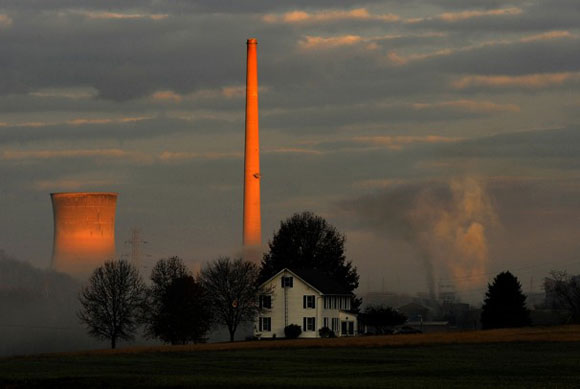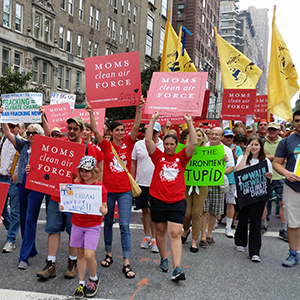
This post was written by Jia Lynn Yang for the Washington Post:
BEVERLY, Ohio — The Muskingum River coal-fired power plant in Ohio is nearing the end of its life. AEP, one of the country’s biggest coal-based utilities, says it will cut 159 jobs when it shuts the decades-old plant in three years — sooner than it would like — because of new rules from the Environmental Protection Agency.
About an hour’s drive north, the life of another power plant is just beginning. In Dresden, Ohio, AEP has hired hundreds to build a natural-gas-fueled plant that will employ 25 people when it starts running early next year — and that will emit far fewer pollutants.
The two plants tell a complex story of what happens when regulations written in Washington ripple through the real economy. Some jobs are lost. Others are created. In the end, say economists who have studied this question, the overall impact on employment is minimal.
“If you’re a coal miner in West Virginia, it’s not a great comfort that a bunch of guys in Texas are employed doing natural gas,” said Roger Noll, an economics professor at Stanford and co-director of the university’s program on regulatory policy. “Some people identify with the beneficiaries, others identify with those who bear the cost, and no amount of argument is ever going to change their minds.”
The arguing has lately turned into a brawl.
House Republicans have identified 10 “job-destroying regulations” they want to repeal, and a steady stream of bills have been proposed to block environmental rules governing everything from cement plants to boilers. GOP candidate Mitt Romney has vowed that on his first day as president, he would “tear down the vast edifice of regulations the Obama administration has imposed on the economy.” The White House, meanwhile, says it is making a determined effort to assess how rules are affecting jobs.
The critique of regulations fits into a broader conservative narrative about government overreach. But it also comes after a string of disasters in recent years that were tied to government regulators falling short, including the financial crisis of 2008 and the BP oil spill and West Virginia mining accident last year.
Data from the Bureau of Labor Statistics show that very few layoffs are caused principally by tougher rules.
Whenever a firm lays off workers, the bureau asks executives the biggest reason for the job cuts.
In 2010, 0.3 percent of the people who lost their jobs in layoffs were let go because of “government regulations/intervention.” By comparison, 25 percent were laid off because of a drop in business demand.
Set along a bucolic stretch of road two hours east of Columbus, the smokestacks of the Muskingum River plant rise suddenly from the landscape like skyscrapers. Beside the plant, huge mounds of coal wait to be lifted by a conveyor belt, then dumped into machines to be pulverized into powder before being burned.
Last year, the plant emitted 98,515 tons of sulfur dioxide, the third-highest total in the country, according to EPA data.
The agency is tightening limits on sulfur dioxide emissions under the Cross-State Air Pollution Rule. To comply, many older coal plants must install enormous scrubbers, which remove sulfur dioxide from the exhaust emitted by the smokestacks.
Built more than 50 years ago, the Muskingum River plant has no scrubbers, and the company says it cannot add them in time to meet the EPA’s deadlines.
AEP chief executive Mike Morris said that retrofitting plants would add jobs but that he needs more time from the EPA.
“We have to hire plumbers, electricians, painters, folks who do that kind of work when you retrofit a plant,” Morris said.
Another AEP coal plant in nearby Conesville required more than 1,000 temporary workers to build a scrubber for one of its units. The plant then added 40 full-time employees to monitor the scrubber, which doubled the footprint of the unit. The device requires so much machinery that it has its own control room.
Critics from groups such as the Environmental Defense Fund say that AEP has had plenty of time to comply with the rules, which have been years in the making, and that some of these coal plants are too old and too dirty to continue operating.
“Everyone has this idea that the EPA could shut a plant down,” said Rachael Belz, organizer of the coal program at Ohio Citizen Action. “But these decisions are being made by AEP, or Duke Energy. These are business decisions.”
Some of the coal plants are approaching the end of their life spans anyway. And the price of natural gas has plummeted as people have discovered how to unlock gas from shale rock.
“The coal-to-gas switch is already on for pure economic reasons,” said Mark Fulton of Deutsche Bank.
He recently co-authored a study concluding that, by 2020, the shift to natural gas and renewables will generate a net 500,000 jobs in the United States.
Standing on the construction site of AEP’s natural-gas plant in Dresden, Ron Borton spoke excitedly about the future.
Borton spent 20 years working at the Conesville coal plant before becoming operations and maintenance superintendent of the Dresden project two years ago.
“I looked at this as an opportunity to learn something new,” he said.
But the Dresden plant will require fewer workers. There will be 25 full-time AEP employees; there are 159 at Muskingum.
“Our level of automation is really heavy,” Borton said. “One guy could run this plant.”
There is no question that a regulation can add costs for businesses and sap the resources and time of busy executives. But recently, more in Washington argue that getting rid of regulations will directly create jobs.
“Based on the available literature, there’s not much evidence that EPA regulations are causing major job losses or major job gains,” said Richard Morgenstern, a senior fellow at the nonpartisan research group Resources for the Future.
A decade ago, in a landmark study on the effect of regulations on four heavily polluting industries — pulp and paper mills, plastic manufacturers, petroleum refiners, and iron and steel mills — Morgenstern and others concluded that spending to comply with rules does not cause “a significant change” in employment. When jobs were lost, they often were made up elsewhere in the industry. For every $1 million companies spent, as many as 1 1/2 net jobs were added to the economy.
Regulatory experts say that viewing a rule solely through the lens of whether it will cost jobs misses the point.
Noll, the Stanford professor, said, “The right question is: On balance, does our society benefit?”
Read the original Washington Post article here.




